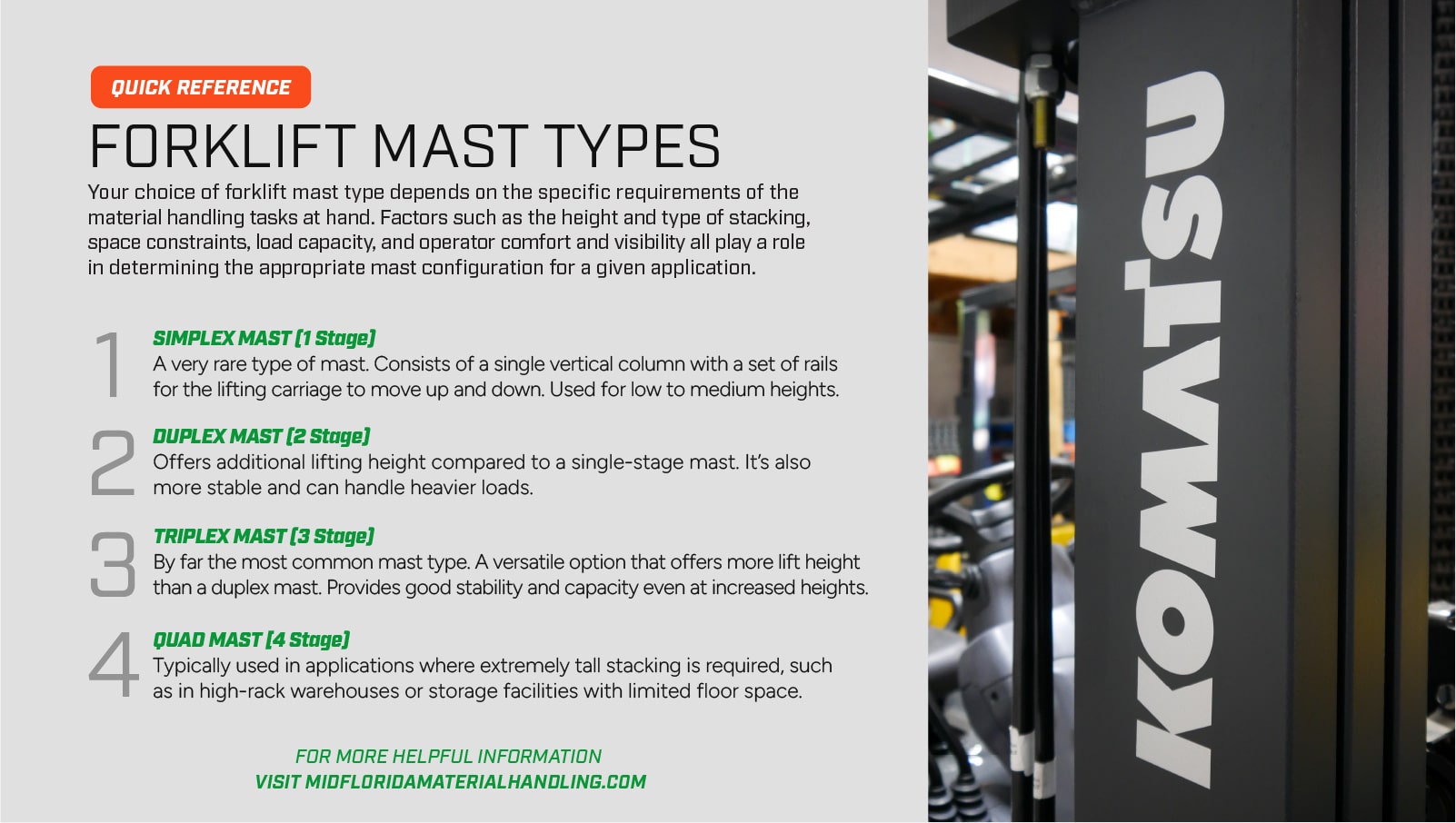How to Choose the Right Forklift Mast
One of the key components of a forklift is its mast, which plays a crucial role in you equipment’s overall performance, versatility, and safety. Because different mast types are designed to address specific operational requirements and environmental conditions, it’s a one of the most important factors to consider before buying a new forklift.
In this guide, we’re going to cover everything you need to know when deciding on the right forklift mast for your needs.

Before diving into the factors to consider, let’s gain a basic understanding of forklift masts. The mast is the vertical assembly that lifts and lowers the load. It consists of an outer upright (the main column), inner uprights (channels or rails), and rollers or slides that allow smooth vertical movement. Forklift masts come in several configurations, each offering unique advantages and capabilities.
Now, let’s get into the most important factors to consider when choosing what forklift mast is right for your needs.
1. Load Capacity and Height Requirements
The first step in choosing the right forklift mast is to determine the maximum load capacity needed for the job at hand. Consider both the weight of the loads and the maximum elevation you need to reach. Different mast types have varying load capacity and lift height capabilities. Make sure to choose a mast that can handle your specific requirements without overloading or underutilizing the forklift.
2. Mast Types
There are three primary types of forklift masts:
Simplex (Single Stage) Mast:
This very rare type of mast consists of a single vertical assembly and is suitable for applications where lift heights are relatively low. They are simple, cost-effective, and provide good visibility for the operator. Standard masts are commonly used indoors and in warehouses.
Duplex (Two-Stage) Mast:
Duplex masts feature an additional sliding section, allowing for increased lift height. They are ideal for medium-height applications and offer a balance between height and visibility. Duplex masts are commonly found in distribution centers and storage facilities.
Triplex (Three-Stage) Mast:
Triplex masts are by far the most common forklift mast type. They have two additional sliding sections, providing the highest lift height potential. These masts are suitable for multi-level racking and outdoor use where tall stacking is required. Keep in mind that as the number of stages increases, visibility may be slightly compromised.
Quad (Four Stage) Mast:
Four stage forklift masts are typically used in applications where extremely tall stacking is required, such as in high-rack warehouses or storage facilities with limited floor space.
Tip: Here’s a quick downloadable summary for your future reference. Please feel free to download and share.

3. Visibility & Space Constraints
Consider the visibility requirements of your operation. While triplex masts offer greater lift heights, they may reduce operator visibility due to the additional sliding sections. If your application involves tight spaces or the need for precise maneuvering, a standard or duplex mast might be a better choice to ensure optimal visibility.

4. Application and Environment
Different environments may have varying height and reach requirements. For example, warehouses with high racking systems will require a forklift with a higher lifting height capability, which might be achieved with a triple-stage or quad-stage mast. On the other hand, outdoor construction sites might require a forklift with a lower mast for easy maneuverability and visibility.
5. Attachments and Accessories
Consider the attachments and accessories you will need to use with your forklift. Some mast configurations may limit your ability to use certain attachments effectively. Make sure the chosen mast type can accommodate the attachments required for your specific tasks.
6. Maintenance and Service
Different mast types have varying maintenance requirements. Generally, simpler mast configurations (such as standard masts) are easier to maintain and service. Complex masts with multiple stages may require more attention and maintenance over time.
Moreover, planned maintenance helps to retain the value of the forklift over time, making it easier to sell or trade when it reaches the end of its operational life.
Choosing the right forklift mast is a critical decision that can significantly impact the efficiency and effectiveness of your material handling operations. By carefully considering factors such as load capacity, lift height, visibility, application, and attachments, you can make an informed choice that aligns with your current and future operational needs.
If you have more questions about forklift masts or any other material handling equipment please feel free to contact us. Our team would be happy to help!







